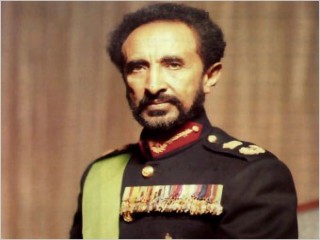
Haile Selassie I biography
Date of birth : 1892-07-23
Date of death : 1975-08-27
Birthplace : Ejersa Goro, Ethiopia
Nationality : Ethiopian
Category : Politics
Last modified : 2011-06-01
Credited as : Emperor of Ethiopia, Power of the Trinity,
Haile Selassie I was an emperor of Ethiopia whose influence as an African leader far surpassed the confines of his country.
Haile Selassie was born Tafari Makonnen on July 23, 1892, the son of Ras Makonnen, a cousin and confidant of Emperor Menilek II. Baptized Lij Tafari, Haile Selassie spent his youth at the imperial court of Addis Ababa, where, surrounded by constant intrigues, he learned much about the exercise of power. Menilek no doubt recognized Tafari's capacity for hard work, his excellent memory, and his mastery of detail when he rewarded the youth's intellectual and personal capabilities by appointing him, at the age of 20, dejazmatch (commander) of the extensive province of Sidamo.
Upon the death of Menilek in 1913, his grandson, Lij Yasu, succeeded to the throne. Yasu's apparent conversion to Islam alienated the national, Christian church and gave impetus to the opposition movement led by Ras Tafari (as Haile Selassie was now designated), which joined noble-men and high church officials in deposing Yasu in 1916. Zawditu, the daughter of Menilek, then became empress, with Ras Tafari appointed regent and heir to the throne.
Throughout the regency the Empress, conservative by inclination and more concerned with religion than politics, served to counteract Ras Tafari's rising interest in national modernization; the result was an uneasy coalition of conservative and reforming forces which lasted for nearly a decade. In 1926 Tafari took control of the army, an action which, when coupled with his previous success in foreign affairs, including admission of Ethiopia to the League of Nations in 1923, made him strong enough to assume the title of negus (king). When Zawditu died in April 1930, he demanded the title negasa negast (king of kings) and took complete control of the government with the throne name of Haile Selassie I ("Power of the Trinity").
In 1931 the new emperor promulgated a written constitution to symbolize his interest in modernization and intention to increase the power of central authority, which had been waning since the death of Menilek. Haile Selassie's efforts were cut short, however, when Mussolini's Italy invaded the country in 1935. The Italian military deployed superior weaponry, airplanes, and poison gas to crush the ill-fated resistance led by the Emperor; the ensuing Fascist occupation marked the first loss of national independence in recorded Ethiopian history. In 1936 Haile Selassie went into exile in England, where he appealed in vain to the League of Nations for help.
In early 1941 British expeditionary forces, aided by the heroic Ethiopian resistance, liberated the country, enabling Haile Selassie to triumphantly reenter his capital in May. The centralized Italian colonial administration, backed by force and with a vastly improved road network, meant that the Emperor returned to find that a great deal of provincial autonomy had been destroyed, leaving him in certain ways stronger than before he left. Throughout the next decade he rebuilt the administration, improved the army, passed legislation to regulate the government, church, and financial system, and further extended his control of the provinces by crushing revolts in Gojjam and Tigre. But in general the Emperor had gradually grown more cautious, and in his reluctance to antagonize conservative elements by any "hasty" modernization he allowed pitifully little infusion of new blood into the government.
In the 1950s Haile Selassie worked for the absorption of the important Red Sea province of Eritrea (accomplished in 1962), founded the University College of Addis Ababa, and welcomed home many Ethiopian college graduates from abroad. His Silver Jubilee of 1955 served as the occasion to present a revised constitution, followed in 1957 by the first general election. Haile Selassie's continued efforts to hold political balance between several major politicians and the recurrent frustration of many newly returned graduates, who still found few places in government, eventually led dissident elements to attempt a government coup in December 1960. The coup failed, but it gave a short and violent jolt to the heretofore uneventfulness of Ethiopian politics and hinted of future possibilities.
In the 1960s the Emperor was clearly recognized as a major force in the pan-African movement, demonstrating his remarkable capacity for adapting to changing circumstances. It was a great personal triumph for him when, in 1963, the newly founded Organization of African Unity established its headquarters in Addis Ababa. Unlike other African leaders, Haile Selassie, of course, had not had to struggle once in office to prove his legitimate authority to his people; his control of government for over 40 years had given him enough time to identify with it.
By 1970 the Emperor had slowly withdrawn from many day-to-day administrative concerns and had become increasingly involved with foreign affairs. He probably made more state visits than any other head of state, enjoying such jaunts for their own sake even when they had little practical use. To him diplomacy seemed inseparable from prestige.
At home Haile Selassie more than ever evinced a trait of caution in his approach to modernization. Though receptive to Western innovations, he never throughout his long reign advanced faster than the consensus would allow, although by his fortieth year in power he appeared somewhat more concerned with adjustment to, and authorization of, change rather than with the active initiation of changes themselves.
A famine in Wello province in 1973 seriously undermined the credibility and legitimacy of Selassie's regime. With a strain on the nation, Selassie was forced to abdicate on September 13, 1974. The new octogenarian emperor Selassie spent his final year of life on house arrest. His death was announced by the Dergue on August 27, 1975. The man who led Ethiopia for 60 years, did not even have a funeral service. The exact location of his grave has never been revealed.


















